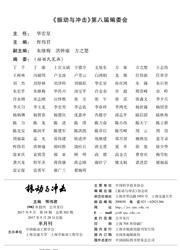

 中文摘要:
中文摘要:
行星齿轮箱振动信号包含多种频率成分和噪声干扰,频谱具有复杂的边带结构,容易对故障识别造成误导甚至引起错判.在不同故障状态下,行星齿轮箱振动信号的多域特征量将偏离正常范围且偏离程度不同,根据这一特点,提取振动信号的时域、频域特征参量用于故障识别.为了避免传统分析方法中负频率及虚假模态问题,增强对噪声干扰的鲁棒性,采用局部均值分解法将信号自适应地分解为单分量之和,提取时频域单分量瞬时幅值能量.针对多域特征空间构造过程中出现的高维及非线性问题,采用流形学习对数据进行降维处理.提出基于改进的虚假近邻点的本征维数估计及最优k邻域确定方法,并通过等距映射对多域特征空间进行降维分析.对于行星齿轮箱实验信号,根据样本流形特征聚类结果,分别识别出了太阳轮、行星轮和齿圈的局部故障,从而验证了上述方法的有效性.
 英文摘要:
英文摘要:
The vibration signals of planetary gearboxes are composed of complex frequency components and interfering noises, and their spectra have intricate sidebands, which cause difficulty in and even misleading fault identification. In different fault cases, the vibration signatures in multiple domains typically differ from normal states with different discrepancies. Based on this hypothesis, time and frequency domain features are extracted for the purposes of fault identification. The vibration signal is adaptively decomposed into a set of mono-components, and the instantaneous energy of each mono-component is calculated in time-frequency domain by exploiting the merits of local mean decomposition, including its better robustness to noise and freedom from pseudo-mode and negative frequency problems. Manifold learning is utilized to tackle the high-dimensionality and non-linearity aspects of multiple-domain feature space construction. A new method is proposed for estimating the intrinsic dimension and selecting the k-nearest neighborhood based on the improved pseudo-nearest neighbor. In addition, isometric feature mapping (ISOMAP) is utilized to reduce the dimensions of the multiple-domain feature space. The proposed method is validated by analyzing the planetary gearbox lab experimental dataset. Based on the clustering analysis results of the extracted manifold features, the localized faults on the sun, planet, and ring gears are successfully identified.
 同期刊论文项目
同期刊论文项目
 同项目期刊论文
同项目期刊论文
 期刊信息
期刊信息
